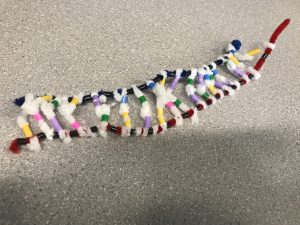
DNA Model Lab
- DNA – deoxyribonucleic acid – is a nucleic acid polymer that is shaped like a double-helix with rungs, and is found in our cells. Its backbone is made of sugar – deoxyribose – and phosphate. Its rungs are made of two bases hydrogen-bonded to each other (adenine to thymine, and guanine to cytosine). Either strand of DNA is antiparallel to each other, and also the strands are complementary; if one strand is known, the other one can be known as well. Like a photo and its negative. The opposite of one backbone should be reversed by the other backbone.
2. This activity is good at showing which base bonds to which, and the positions of the phosphate groups, and demonstrates the antiparallel and complementary nature of DNA. It is also good at showing the long, twisted, ladder-like structure of DNA. However, it does not show the actual sugars or molecules; it gives a more macroscopic view of DNA. One way this model can be improved is also looking at the molecular structure of the sugars, phosphate groups, and the bases. Moreover, since DNA should be very flexible, other material besides pipe cleaners can be used next time. We could use string for our backbones. And colored straws for our bases. Tie the string around the straws to create the structure. It wouldn’t necessarily look like traditional DNA structure but functionally is far more functional and realistic.
Replication Lab
- Occurs before cell division, during the interphase of mitosis.
- Where the DNA begins to unwind the alpha helicase and unzip its H-bonds utilizing DNA Helicase, then begins to add its complementary base pairing through the help of polymerase; nucleotides move into place and form H-bonds with newly formed “partners”, then join the adjacent nucleotides, where the leading strand continuously unzips the DNA, and the lagging strand DNA ligase glues fragments of the unzipped DNA.
- The model today had multiple different problems. It had difficulty joining the model the complementary base pairing and the joining of adjacent nucleotides we tied the complementary bases to the mother bases first then added the length of pipe cleaner which had phosphate groups – modeled by black beads – attached to it. This was accurate because it showed which bases joined to which; how every base had a specific pair. This was inaccurate since the sugar-phosphate backbone is not just a long string that attached to pre-bonded bases, rather it is formed individually for every base.
RNA Transcription Lab
- mRNA copies the information carried from 1 gene on DNA. mRNA gives instructions which allow the ribosome to construct the proper sequence of amino acids to produce the required protein. DNA stores information while mRNA gives instructions.
- Transcription is the process in which information from 1 DNA gene is copied onto a mRNA strand. The process of transcription is broken down into three phases. Unwinding and Unzipping, Complementary base pairing, and Separation.
- Today’s activity did a good job in showing the general process of transcription. It did not do a good job in showing how a single gene (a certain part of the DNA strand) was transcripted.
Protein Synthesis Lab
- Describe the process of translation: initiation, elongation, and termination
Protein synthesis begins with initiation where the mRNA is held by the ribosome and the start codon AUG is read by the P-site. Matching tRNA brings in amino acids. The second phase of translation is elongation where the amino acid continues to grow and form a polypeptide. The mRNA codon is read by the A-site and brings in a matching tRNA. The P-site amino acid from tRNA is then transferred to the A-site tRNA. The final phase of translation is termination. The process of elongation is repeated until a special codon called a Stop Codon is reached. The ribosome is then separated from the mRNA while the tRNA separates from the polypeptide.
- How did today’s activity do a good job of modeling the process of translation? In what ways was our model inaccurate: Reasons stated below
Through visual presentation, it was quite effective, and paper is quite easy to use. There were some flaws. The mRNA travels through the cytoplasm into the ribosome, yet in this activity, it is at times very difficult to understand what exactly we’re doing or the reason why we are doing it.










